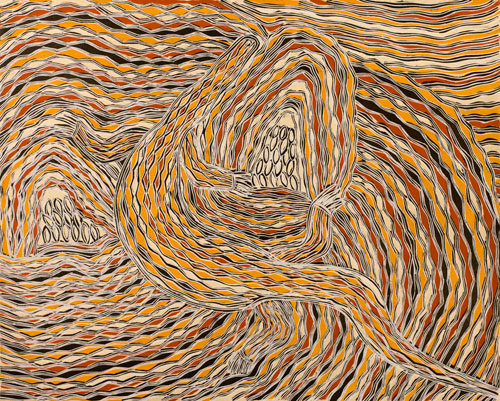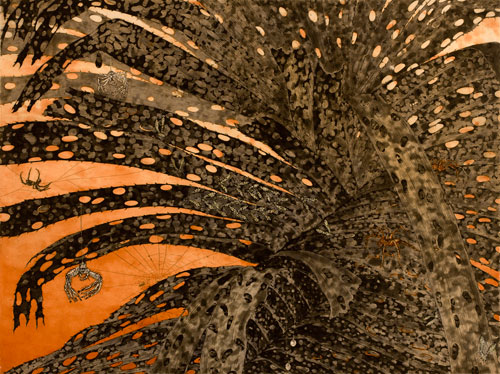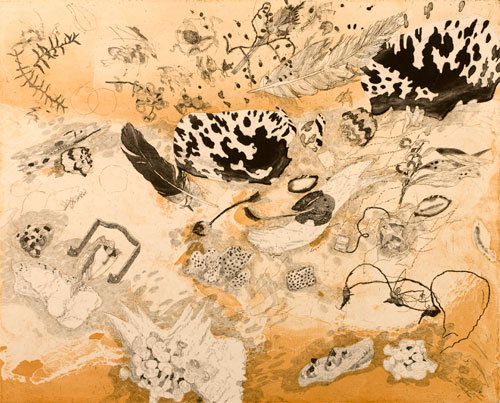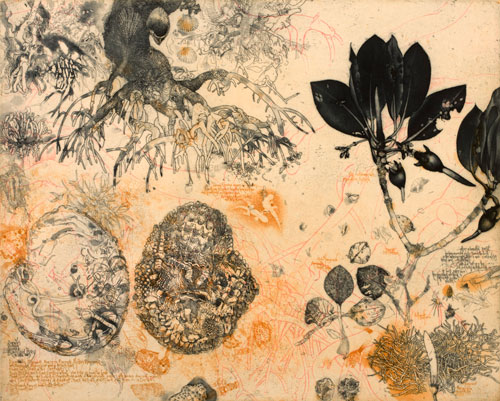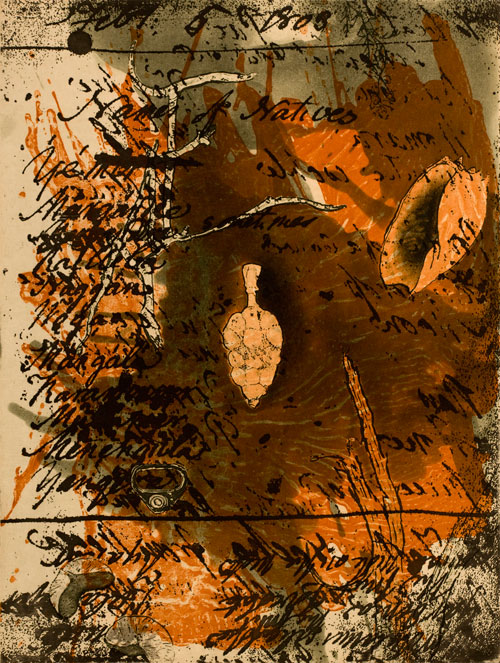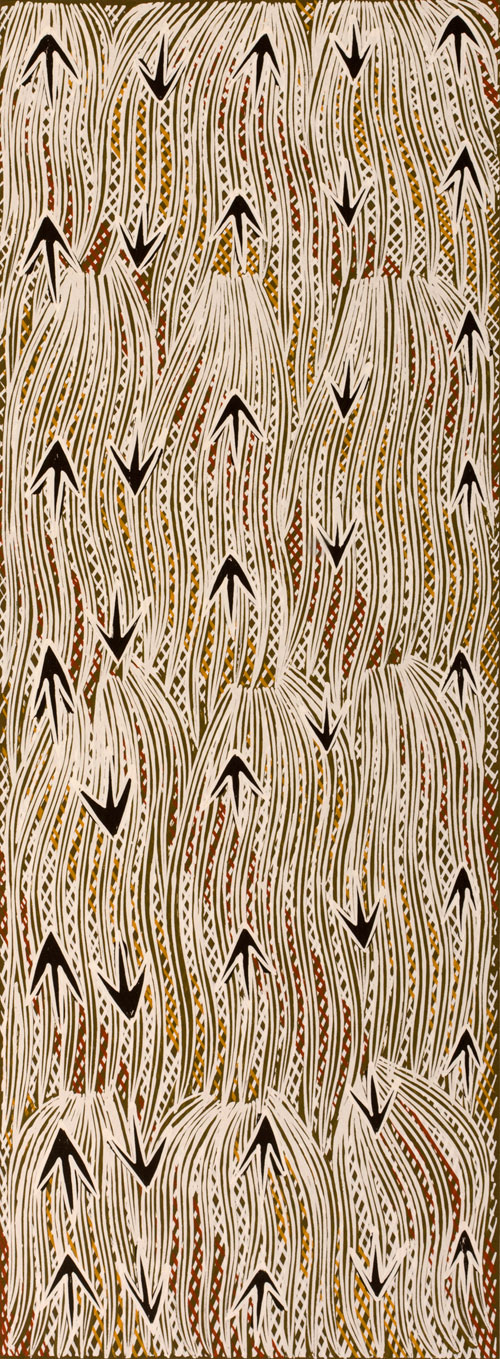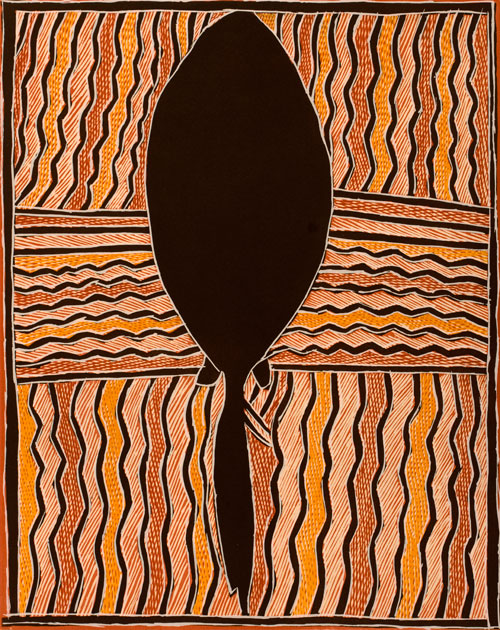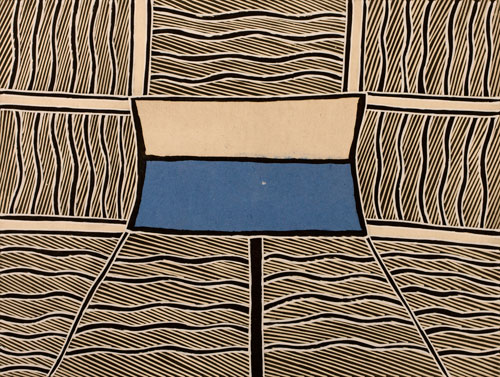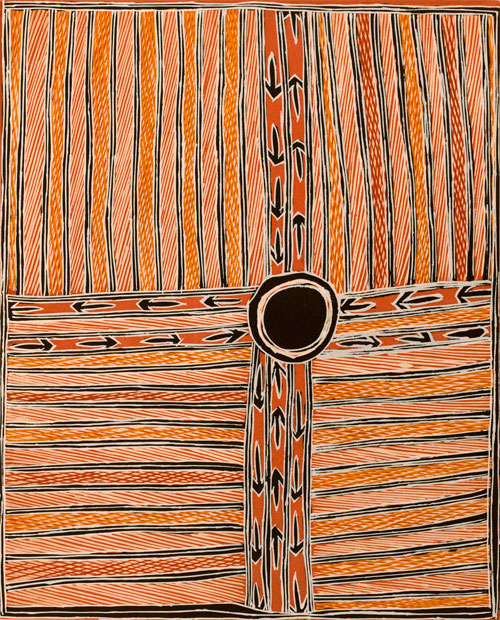

Nomad Art Productions, Darwin, August 2010
Travelling to museums throughout Australia, 2011–14
by Dr JANET McKENZIE
Blue Mud Bay is a famous and wonderful place, in a famous and wonderful region. Northeast Arnhem Land is a bastion of Australian Aboriginal cultural and biological knowledge. It is linguistically diverse and biologically rich and is the home of the unanimously respected Yolngu clans. The region is famous for a number of spectacular episodes that have occurred there since settlement. There have been notorious killings of Japanese fishermen and police, famed bark paintings and large mining operations. However, Blue Mud Bay is most famous for the momentous High Court decision in 2008 to give traditional owners exclusive rights over tidal waterways fringing Aboriginal Land.
Yilpara on Blue Mud Bay is a special place. Djalkiri is a special word. It has several meanings, one of which relates to footprints, but also refers to deep, hidden knowledge. (Glenn Wightman, 2010)1
Djalkiri: We are Standing on their names: Blue Mud Bay, (2009–2010) a cross-cultural project, the exhibition of which, was launched in Darwin, in August 2010. It will travel to museums and art centres throughout Australia over the next four years. A project of major importance, Djalkiri involved nine Indigenous and non-Indigenous artists, as well as scientists and printmakers and a back up team. Nomad Art Productions conceived and organised the project, which took place in the unspoiled environment of Blue Mud Bay in Arnhem Land. Based in Darwin, Nomad Art was established by Rose and Angus Cameron, whose experience in the fields of Indigenous art projects and education has resulted in the meticulous assemblage of information in the spirit of collaboration. The educational kit that accompanies the launch of the project reflects their work over a lengthy period where the dissemination of knowledge about Indigenous Australian culture is seen as imperative to a more balanced society in the future.
The concept for Djalkiri came during the 150th anniversary of the publication of On the Origin of Species by Charles Darwin (Its full title was On the Origin of Species by Means of Natural Selection, or the Preservation of Favoured Races in the Struggle for Life. Worldwide commemorations of the 150th anniversary of the publication of On the Origin of Species and the bicentenary of Darwin's birth took place in 2009. They celebrate the ideas which “over the last 150 years have revolutionised our understanding of nature and our place within it”.2 It is particularly fitting that, in the city that was named after him, a project was instigated that has presented an alternative to Darwin’s “findings” which were in turn used to sanction Western notions of cultural supremacy and led to the destruction of Indigenous culture. Today Darwin remains the only city in the Northern Territory of Australia, an area of pivotal significance for Australia’s Indigenous population, and an area of seminal importance for Aboriginal Land Rights.
In terms of colonial policy and attitudes to nomadic societies that appeared to the 19th-century eye to be less evolved, Darwin’s views on living things evolving from common ancestors made an understanding of Aboriginal culture impossible. The past 30 years in particular, have seen the study of Aboriginal culture expand. The Djalkiri project is a unique attempt to learn from the Yolngu people of Blue Mud Bay, who have a very different view: “Yolngu belief and knowledge is contained within songs, stories, ritual and art. Paintings are like maps depicting living things and elements of the world. All have meaning and are based on an organization of knowledge and relationships. This is expressed through Djalkiri, which actually means foot or footprints, but when applied to Yolngu law it takes on a more profound meaning referring to the underlying foundation of the world.”3
The idea, Angus Cameron points out, “was to bring a group of artists, scientists and printmakers together to think about Western scientific ideas and knowledge together with the holistic perspective of Yolngu people”. The title of the exhibition, Djalkiri: We are standing on their names – Blue Mud Bay, came from the words spoken by clan leader Djambawa Marawili. “It is about cultural inheritance of the ancestors, it is also about respecting different cultures and beliefs, walking together in the footsteps of their knowledge.” 4
The five local artists from Arnhem Land, Djambawa Marawili AM (Australian Medal or Order of Australia), Marrirra Marawili, Marrnyula Mununggurr, Mulkun Wirrpanda and Liyawaday Wirrpanda, were joined by Fiona Hall from Adelaide, by John Wolseley from Melbourne, by Jörg Schmeisser from Canberra and by Judy Watson from Brisbane. They were joined by a number of workshop facilitators: Basil Hall (printmaker), Glenn Wightman (ethno-biologist), Professor Howard Morphy (anthropologist), Peter Eve (photographer), and Angus and Rose Cameron (curators and project managers).
The visitors to the project flew from Darwin and drove to the remote community of Yilpara on Blue Mud Bay in the easterly region of Arnhem Land where they were given a moving reception from the whole community who had gathered on the beach overlooking the bay. The visitors “were met by spear wielding, dancers, looming and retreating in a traditional test of the new relationship. The Yolngu then led the visitors to their campsite for a smoking (cleansing) ceremony. The camp consisted of traditional raised bark shelters, outdoor kitchen, bower shelter and shower block. The site was made in the shape of Lulumu, the ancestral stingray who had created the land before returning to the sea. That night Djambawa Marawili sang of Lulumu and the branches of the trees that waved above our heads in the evening breeze”.5
Fiona Hall observed:
“For each of us, home is a place that is not only fixed on a map but floats along the tributaries of our consciousness. The place I come from is, I think, located somewhere on the ebb tide of the world at large, a place in a culture in a continual state of flux, drifting without an anchor. It is a place which is sharing less and less of its space with its kindred plants and animals, and which is inundated time and again by the tidal waves of its own gross superfluities. Too often the world I belong to absolves itself of guilt and responsibility for its actions by washing away the traces of its murky history.. I learnt at Blue Mud Bay, that Yolngu culture is a fluid one, with a deep knowledge of and respect for the source from which it flows. A tide of goodwill from the community there invited us to walk and sit together, to create Djalkiri. In the slipstream of this collaboration our different worlds are flowing together, making ripples on the surface where our cultures meet. I think I see a shimmer on the horizon.”6
The adventure and organisation of the Djalkiri project are described in detail in the catalogue and on the website. Glenn Wightman observed, “Watching the artists interact with the incredible biodiversity of Yilpara and the Blue Mud area, with the senior biocultural knowledge custodians who accompanied us on country, with each other and with the other members of the Djalkiri team was both enthralling and highly educational.”7
Basil Hall, who originally trained with Jörg Schmeisser at the Canberra School of Art, and who has played a seminal role in the introduction of printmaking techniques to Aborigines, and the establishment of community printmaking studios, underpinned the production of the artworks. As Howard Morphy has pointed out, “Etching is a magical process in which unique ideas are created in a reproducible form”, having the advantage in a collaborative project, “that the dialogue with the artists continues long after the first encounter”.8 The works that appeared from the project are all challenging and outstanding works.
Djambawa Marawili is a leader of the Madarrpa clan and an important activist and administrator who had been responsible for the present relationship that exists between non-Aboriginal people and the Yolngu people of North East Arnhem Land. He was instrumental in Aboriginal Land Rights from the late 1980s to the recent 2004 Federal Court Sea claim, which resulted in the 2008 High Court ruling that the Yolngu people owned the land between the high and low water mark at Blue Mud Bay. Drawing on the sacred foundation of Yolngu culture he is dedicated to informing the wider world of Yolngu culture and struggling for their rights. His etching and screen print represents the sacred and dangerous area of Garrangali where Baru the crocodile nests. The meticulous and skilful patterning is layered with the ancient belief system. “Baru, the ancestral crocodile ventures here from Yathikpa, bringing the power and authority of the Ancestral Fire with him. The sacred clan design of cross-hatched ribbon swirling flame denotes this fertile mix of waters and fire, in this sacred area Garrangali is revered as a resevoir of Madarrpa soul. To venture into these parts is for those with appropriate knowledge and the preparedness for the intense heat and the ire of the crocodile”.9
Liyawaday Wirrpanda’s screenprint represents her Dhudi-Djapu clan’s design of country that was transformed and sanctified by the principal creator of the Dhuwa moiety – the Djan’kawu. The image depicts floodwaters on these plains where grasses are suspended by the sacred water. The dramatic depiction of the stingray, the Gurrtjpi, which is much hunted in the shallow waters of Blue Mud Bay, is by Marrirra Marawili, an elderly artist and community leader. He has been an important and widely recognised artist since the 1970s. The stingray is “also a totem for the Madarrpa at Båniyala as they talk of Gurrtjpi having a path of creation at Båniyala. A few hundred yards down the beach, a small tidal creek cuts through the dunes to the flat country immediately behind. This creek named Måwangga was used by Gurrtjpi to track back into the bush. Here he bit into the country forming several small billabongs, a source of water for Yolngu living there. His path continued along the direction that is now the Baniyala air strip to flat sandy country before heading out to the point Lulumu to become a white rock”.10
Marrnyula Mununggurr is one of many accomplished women artists in Arnhem Land. During the Djalkiri project following a talk where Djambawa was telling a story about Yilpara and the sea rights ceremony, she had a dream about the Bawu, the sailing cloth, which is the clan design for the Madarrpa and Mangalili. She sought permission from Marrirra and Djambawa to paint her mother’s design. With permission granted she used the story for her print.
She explains:
“The design in the middle is Bawu. On the top the white represents the clouds and the blue represents the water. The lines around Bawu represent the salt-water-Mungurru connected to Yilpara and Djarrakpi homelands. This is my first painting from my mother’s clan. It tells the story of sea rights. The ceremony for sea rights at Yilpara had this flag situated in the sea connecting clouds and water.”11
Mukluk Wirrpanda is the daughter of the great Yolngu leader Dhakiyarr Wirrpanda. She is recognised as a leader for her extensive knowledge of the Dhudi-Djapu clan from Dhuruputjpi, one of the few women to hold such status. Her artistic position is also one of authority, for she was an early practitioner of sacred clan imagery using earth pigments. She paints on bark, larrakitj (memorial poles) and yidaki (didjeridus) as well making carvings and weavings. Her work has been widely exhibited. Her work for the Djalkiri project, combining etching and screen print, Birrkuda, is from her mother’s clan, her miny’tji (design). With her two brothers she looks after the design and the land since her mother’s death, for her mother’s grandchildren as well. The clan history is a sensitive one, since they were victims of a massacre in the early 1900’s. As a consequence this is a rarely reproduced design.12
It is not surprising that the non-Indigenous artists visiting Blue Mud Bay were overwhelmed and humbled by the remarkable art works they saw there, and the extraordinary power in spiritual terms of the land and the multifarious ways the creation stories could be passed on in visual terms. John Wolseley described such an experience: “Since the early days of European settlement there has been a tradition of heavy-footed artists drawing and documenting parts of the continent about which they know little. As for myself, when I arrived at Baniyala I was just plainly discombobulated. Here I was, with Yolngu artists of such distinction and with such brilliant ways of expressing in paint their vast knowledge about the place that I thought – goodness me – I’m starting from scratch”.13
In fact, John Wolseley has exerted a considerable influence on art and culture in Australia since arriving there from England, in 1976, by virtue of his independent vision in relation to land, Indigenous culture, history and evolution. “I genuinely feel that the land has not really been painted yet – except by some singular artists and, of course, Aboriginal ones, and this is because we’ve imposed European or other foreign models on something most peculiarly different”.14
He has adopted a scientific exactitude to his study of bio-geography of northern Australia and Asia. His investigations are based on a holistic view of life where drawing plays a pivotal role. In drawing Wolseley seeks a formal language to express the unique and peculiar nature of the Australian environment. Drawing on the spot, he points out is vital in a society dominated by technology and second-hand information. Drawings are essentially explorations, in contrast to the magisterial gaze where ego gets in the way of communing with place.15 He has worked in numerous remote settings in Australia: Arnhem Land, the Tasmanian wilderness and the Mallee region in NW Victoria. His most recent drawings, which have been allowed to float about in the landscape for weeks and months, become the voice of the land. Akin to meditation or prayer these works are evidence of listening to nature, to the essential character of the land, to connecting to a higher order. In this Wolseley makes a unique contribution to Australian culture. Traversing scientific theory and ancient history, Wolseley is trying to give form to his “obsession and fascination with the way every living species is part of the huge dynamic movement of the earth and its evolution. If one looks at the frond of a fern say, in its design and structure, there lies the history of the Earth”.16
At Blue Mud Bay he collected random natural objects. Glenn Wightman and Djambawa elucidated his knowledge with scientific and cultural knowledge, which made him feel as if “an invisible ordering force was at play”. Looking at the etchings some time later he observed, “I hope that I may have learnt just a little bit about some of the mysterious systems of correspondences and interconnections which are part of the Yolngu cosmic understanding of the nature of the world”.17
Judy Watson played a unique role, as a visitor to the region but as an Aboriginal descendant of the Waanyi people of northeast Queensland, and an artist of international stature, having represented Australia at the 1997 Venice Biennale. Judy Watson was born in Mundubbera in Queensland in 1959, a member of the Waanyi Aboriginal language group. She co-represented Australia with Emily Kame Kngwarreye at the Venice Biennale in 1997. Her haunting and beautiful works incorporate a celebration of 21st-century Aboriginality – reclamation and revival – as well as being infused with mourning.
Her artworks in a range of media allude to past and present, remembrance and forgetting. Her Guardian figures are created from various media including pigment on plywood. Her images of self are subjectively established, depicted as if from inside the skin – in which she makes a comment on the effective absence and powerlessness of Aboriginal people in political terms.
Referring to the land in 1990, she claims, “when you walk in that country – the earth is beating pulsating heat, blood, heart things are hidden, like the bones of the people who have been there before – you are walking in their footprints”.18 Watson’s ethereal works are intensely personal, where figures hover in space, above the land. Memory, heat, and ancestral presence, are created by Watson’s meticulous treatment of the surface. She trained in print-making, her methods are often exploratory and original embedding the material with a personal iconography and spirituality.
Her etching for Djalkiri: kurajong, disc, sea rights 1 (2010), incorporates documents from the Blue Mud Bay Native Title Case judgement, that recognised Yolngu ownership of the intertidal zone in the Aboriginal Land Rights, Northern Territory Act.19
Glenn Wightman made a study of the plant and animal species depicted in the artworks from the Yilpara field trip, 12–16 October 2009, listing western scientific names and Yolngu. In Fiona Hall’s Pandanus – Gunga, he points out, “Pandanus is an important species for Yolngu and other Aboriginal groups in northern Australia. They provide important food, medicine, fibre resources and a number of minor uses. Pandanus forests fringing waterways are also important habitats and food resources for many animals”.20
Of Jörg Schmeisser’s Mangroves and Notes, Wightman writes, “This plate depicts some of the most important plant and animal relationships in the inter-tidal zone. The Stiltroot Mangrove contains the important food resource of mangrove worms. Drypetes leaves are used as flavouring for cooking saltwater animal foods. Mud crabs are often found in mangrove tree roots. Club Mangrove leaves are used as stingrays for spear practice”.21
Jörg Schmeisser is a printmaker of international stature. He has also been an important teacher in Australia (1978–1997) as Head of Printmaking at the Canberra School of Art, now part of the Australian National University. Schmeisser was born in Germany in 1942 where he grew up and went to school before moving to Kyoto for post-graduate studies in 1968. In his early career Jörg Schmeisser worked as an archaeological draughtsman, which, “ingrained in him the habit of clinical, scientific observation in order to convey in an immediate and objective way whatever details of the whole or part of an object were required by the archaeologist. Artistic persona was not something that intruded in these exercises”.22 As a young artist he looked to the work of Albrecht Dürer and also to the work of Rembrandt and Leonardo. The very qualities of rigour and meticulous drawing, are those which have always informed Schmeisser’s own work.
Schmeisser’s curiosity takes him to obscure sources and places, where his natural sense of adventure finds wonderment and inspiration. Imagination turns danger into tragedy; the minutiae of life into symbols of hope. He draws with a rare degree of subtlety and technical skill yet he imbues his work with the spirituality. Drawing is therefore a tool with which to make non-verbal statements or to prepare for subsequent works. It is also an art form in its own right.
The Djalkiri project was for Schmeisser, an extension of many aspects of his art practice. The poetic sensibility that has made him a remarkable artist and teacher captured the exploration and openness required to understand other cultures, to be flexible and prepared to change. “Time seems to slow down as I work. The moment is extended, the flow of time measured, departure delayed. While I observe, the other senses are alert: I taste the air and the dust, I feel the rough stones, hear the cicadas, smell the smoke. And somehow this will find its way into the picture. The sketched lines of first thoughts remain on the surface, together with the defined marks of the final image. On the way back to base: baggage, precariously close to the plates, the copper is bruised by the movement of the travelling car, cold weather cracks the ground, the heat will let the block-out stick to my hands. In the end it is both the travel and I, who create the marks, which will make the print of the journey”.23
Angus and Rose Cameron are to be congratulated on bringing together artists of exceptional sensibility and skill, and the team too, who made the final product a reality. Set to spend the next few years travelling around Australia, it is hoped that this exceptional project will further the country’s understanding of what now constitutes an alternative to Darwin’s scientific appraisal of life.
References
1. Glenn Wightman, “Djalkiri Magic”, in Angus Cameron, Djalkiri: We Are Standing on their Names, Blue Mud Bay, Nomad Art Productions, Darwin, 2010, p.15.
5. Angus Cameron, Nomad Art Education Kit: www.nomadarts.com.au
12. Cameron, Education Kit, op.cit.
14. Quoted by Sasha Grishin, John Wolseley: Landmarks II, Craftsman House, Sydney, 2008, p.9.
15. John Wolseley, conversation with Janet McKenzie, 30 May 2009.
16. John Wolseley, “Artist’s Statement: Tracing the Wallace Line”, Roslyn Oxley9 Gallery, Sydney 2001.
18. Judy Watson referring to the work: sacred ground beating heart, (1989), quoted by Queensland Art Gallery website, 1990.
22. Peter Haynes, “Silent Truths”, Jörg Schmeisser: Breaking the Ice (works from the Antarctica, 1998-2003), Edited by David Hansen, Tasmanian Museum and Art Gallery, Hobart, 2003, p.25.
